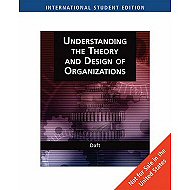|
Understanding the Theory and Design of Organizations
|
|
Richard L. Daft
|

|

My vision for this international edition of Understanding the Theory and Design of Organizations is to integrate contemporary problems about organization design with classic ideas and theories in a way that is interesting and enjoyable for students. Significant changes in this edition include updates to every chapter that incorporate the most recent ideas, new case examples, new book reviews, new end-of-chapter cases, and new end-of-book integrative cases. […]
To engage students in the world of organizations, this edition adds and expands significant features: Leading by Design boxes with current examples of companies that are successfully using organization design concepts to compete in today's complex and uncertain business world, student experiential activities that engage students in applying chapter concepts, new Book Marks, new In Practice examples…
Book Marks… are book reviews that reflect current issues of concern for managers working in real-life organizations. These reviews describe the varied ways companies are dealing with the challenges of today's changing environment. […]
A Look Inside This feature introduces each chapter with a relevant and interesting organizational example. Many examples are international, and all are based on real organizations. […]
In Practice These cases also illustrate theoretical concepts in organizational settings. New In Practice cases used within chapters to illustrate specific concepts include J.C. Penney, Charles Schwab and Company, eBay, the Federal Bureau of Investigation, Ryanair, Chevrolet, Genentech, Tyco International, and Sony. […]
New Concepts
Many concepts have been added or expanded in this edition. New material has been added on culture, learning, and performance; virtual network organization structures; applying ethics to create social responsible organizations; outsourcing; lean manufacturing; customer relationship management; political tactics for increasing and using managers power; applying business intelligence; and the use of global coordination mechanisms for transferring knowledge and innovation. […]
|
|
